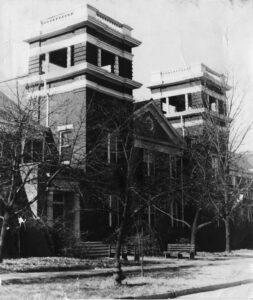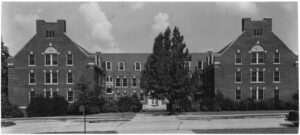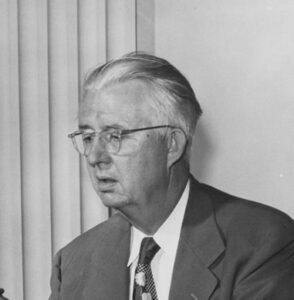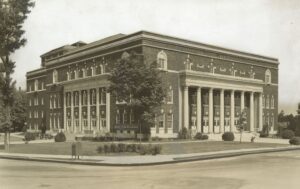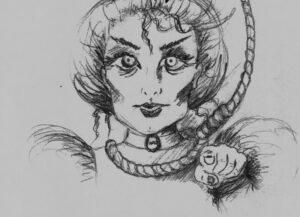To celebrate Halloween, we repeat this blog post, originally posted in October 2012 by Hermann Trojanowski, who retired from Special Collections and University Archives in 2013. We hope you enjoy this extra spooky Spartan Story.
Tales have long circulated about the ghosts that allegedly haunt the campus. In the late 1960s, the Spencer Residence Hall ghost was known simply as “The Blue Ghost” or “The Woman in Blue.” In the early 1980s, students gave her the name “Annabelle,” possibly alluding to the subject of Edgar Allan Poe’s classic poem “Annabel Lee.”
Legend has it that Annabelle is the spirit of a student who hanged herself many years ago in one of the building’s bell towers; however, no such suicide has ever been documented. A member of the residence hall staff reported that Annabelle had “appeared as a blue shadow” on two occasions in the Spencer’s main parlor and when the building was closed for the Summer in 1976, the same staff member heard the ghost “dragging something on the floor out in the lobby.” There have been other reports of a blue haze passing by a second-floor laundry room and of objects being flung across rooms.
In South Spencer in the early 1980s, an apparition reportedly awakened two different staff member on two separate occasions by walking into their rooms. The building had been closed for vacations both times. It is not known whether this was Annabelle or another ghost or ghosts.
Build in 1928, Mary Foust Residence Hall was named for Mary Foust Armstrong, daughter of the college’s second president, Julius Isaac Foust. Mary was a member of the class of 1920 – she died in childbirth in 1925. Some believe that her ghost took up residence in the dormitory that bears her name, because rumors have floated around for years about random “unexpected crying” and “funny noises” on the hall’s second floor. Mary Foust’s portrait, which had hung above the fireplace, disappeared some time back without a trace. Another rumor about Mary Foust Hall was that in the 1950s, three nursing students hanged themselves from the rafters in the attic. Investigations have shown that the structure of the beams would make hanging very difficult but still the rumors persist.
The campus’ most well documented ghost reportedly inhabits UNCG (formerly Aycock) Auditorium, which opened in 1927. An interview with Raymond Taylor who taught drama and play presentation and was the director of dramatic activities on campus from 1921 until his retirement in 1960, reveals that Taylor not only believed in the ghost of UNCG Auditorium, but recounts his personal experiences with the ghost.
According to Taylor, “at one time a sort of colonial mansion stood on the corner where Aycock is. There dwelt in this mansion an old lady all-alone. After a while she became extremely unhappy about her lonely state and went up in the attic and suspended herself from a rope on the rafters. Having committed suicide there, she determined to stay on as a ghost. When they tore down the building, she haunted the area for a long time until Aycock was finally built, and then she adopted that for her home. She seemed, when I knew her to delight in the upper reaches of Aycock foyer where she assumed the guise of lights that flitted from ceiling place to ceiling place and dragging chains and clanking objects over the floor down in the lobby up to my office door.”
Taylor goes on to tell the story of an incident that occurred one afternoon when he and the auditorium’s janitor were working on the set for a play. The whole building was locked up, and since it had been an extremely hot afternoon, he and the janitor undressed down to their briefs to work. Taylor had left his clothes neatly in a pile. During the afternoon, a storm came up that raged and roared for quite a while and after the storm was over, Taylor went upstairs to dress and found that his clothes had been disarranged. He had been wearing a vest with a watch chain across it, and his watch chain had been arranged on the table in the form of a cross. His other clothes were “helter skelter all over the place.” Taylor just knew this was the work of the ghost of UNCG Auditorium.
Many nights, while working in the auditorium, Taylor would hear all sorts of strange noises. He tried to explain some of them by saying that they were the echoes of passing cars or the reverberations of the passing trains shaking the building, but one night he and a colleague, Jimmy Hogue, were sitting in his officer around midnight talking. Hogue was sitting with his back to the door. All of a sudden the door opened, and a cold air came in, and they heard the receding clank of chains. They got up and turned on the lights in the hallway and looked all over, but could never find an explanation for that occurrence.
Students have given the auditorium’s spirit a name, Jane Aycock, and say that she is the daughter of the man for whom the auditorium was previously named; but Governor Charles Brantley Aycock, whose two wives bore him nine children, had no daughter by that name. Supposedly she killed herself in the auditorium, a noose around her neck, her body dangling from the fly-loft over the auditorium stage. But the only deaths the auditorium has witnessed have been those acted out on stage, not over it.
According to an article in the Winston-Salem Journal in 1977, written when the auditorium was 50 years old and was getting ready to reopen after renovations, the drama majors were so attached to the specter that it became something of a tradition to introduce her to new students. “An unsuspecting freshman would be handed a lighted candle and shown the stairway leading to the attic, reportedly the ghost’s favorite turf. Then the drama majors… would solemnly watch as the flickering flame floated away into the gloom. They knew there was a certain spot in the attic where a draft always blew out the candle. It would take a few minutes for the novice spook chaser’s eyes to adjust to the darkness. Then, the victim would see a shape – a human shape – shimmering in the inky blackness. The drama majors always got a kick out of hearing the screams that usually followed. It’s surprising what a coat of luminescent paint can do for a manikin borrowed from the theater’s prop shop.”
By Hermann Trojanowski
